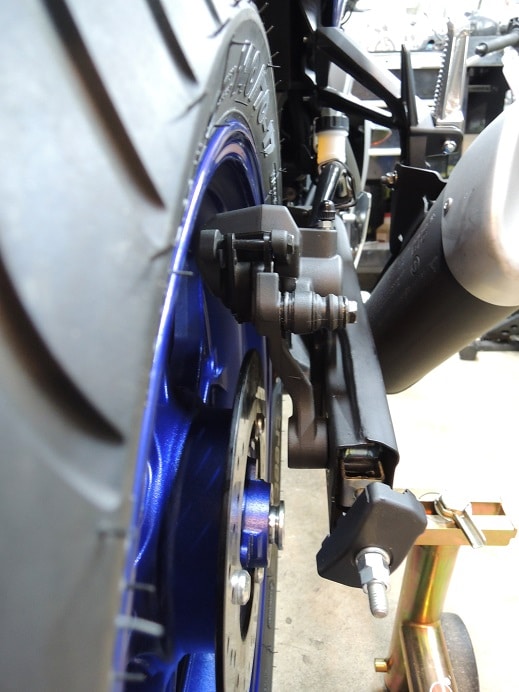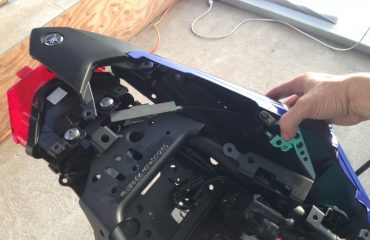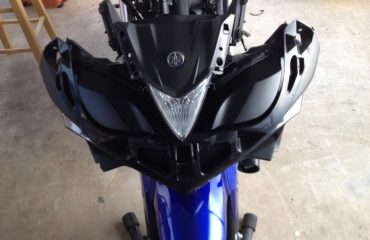How to remove the rear wheel from the Yamaha R3 / MT-03

This post was written by mfgchapin from R3-Forums and I only added a couple extra notes about using a flat blade screwdriver to spread the brake pads slightly if necessary and using duct tape to hold the chain adjusters in place, thank you mfgchapin!
If you’re having a shop mount tires for you, bringing them wheels instead of a whole bike will usually save you about 50%. You also need to take them off to change brake discs, sprocket, bearings etc.
Tools Needed:
22mm socket
19mm socket or wrench
Rear stand
Mallet
Torque wrench
Flat blade screwdriver to spread brake pads
Duct tape to secure chain adjusters while reinstalling wheel
Step 1: Get the bike up on the rear stand and loosen the 22mm nut while holding the 19mm axle head with your wrench, I find this is easiest while sitting on the floor behind the bike. Once the nut is off, stick your feet under the wheel and give the axle a tap to the left with the mallet. Once it’s out, push the wheel forward, take off the chain, then slide the brake caliper out of its rail to the left and up. You shouldn’t let the caliper dangle since it’s on a rubber hose, so either bungee it or set it to the right of the swingarm. You can put a rag under it if you’re worried about scratching anything. The wheel should now easily roll back out of the swingarm.
Step 2: Remove the brake-side spacer and put it in a safe place.
Step 3: Wiggle the sprocket back and forth until it comes out. Try not to set the wheel down on the brake side unless you have an old tire or something soft to prop it up on. I do it with the wheel upright. There is another spacer in the sprocket carrier, but it doesn’t need to come out. Now you’re looking at the rubber cush drives.
Step 4: Remove the cush drives. The wheel is ready for a new tire and there’s nothing left that can easily fall out and get lost in your car or at the shop. This is what you should be left with.
While everything is apart, a little extra grease on the axle and some anti-seize on its threads will make removal just as easy in 5,000 miles.
Installation is trickier and I admit it’s a bit of a booger on this bike, but it gets a lot easier and faster with practice. Again, I find it easiest sitting on the floor. Install the cush drives, sprocket and spacers and roll the wheel as far into the swingarm as it’ll go.
Step 1: The brake caliper is on a bracket with a groove:
that needs to slot onto a tab on the inside of the swingarm:
Put the caliper on the tab and make sure the brake pads are still spread apart. A flat blade screwdriver works well to GENTLY spread the pads. Keep in mind, spreading the pads will force brake fluid back into the reservoir, so if your reservoir is full, or you have removed the oem reservoir, be careful about overflowing or drain some fluid out first. Also, if has been awhile since you changed your pads, the pistons may be very dirty. If so, it’s not a good idea to force the dirty pistons back into the caliper by spreading the brake pads. You may want to clean the pistons first. See Step 3 of my post here on changing brake pads.
Lift the wheel with your feet so the disc is between the pads, but keep the wheel forward in the swingarm. Make sure the spacer on each side stays in. There should be plenty of slack in the chain to get it back on the sprocket. Pull the wheel back while making sure the two chain adjusters at the end of the swingarm stay in place. This is where I recommend wraping a piece of duct tape around the end of each chain adjuster to hold them in place. Slide the axle into the left adjuster hole and line it up with the wheel. Once the axle is all the way through, snug the axle nut down while pressing the wheel forward to make sure your alignment hasn’t changed. Then lightly tap the end of each chain adjuster bolt with a hammer. This will seat the chain adjuster all the way so the end caps don’t wiggle. Check to be sure they don’t wiggle, and check chain tension and alignment, then tighten the axle nut to 57 nm (42 ft lbs) .
Note: Pit Bull makes a really nice “tire wedge” to use instead of your feet. http://www.pit-bull.com/product/F0102-000.html











You must be logged in to post a comment.